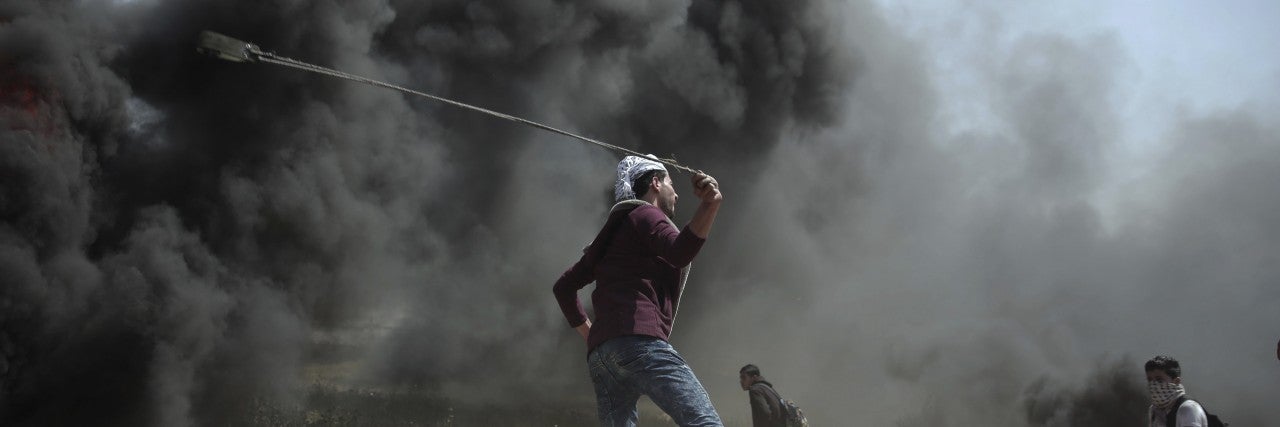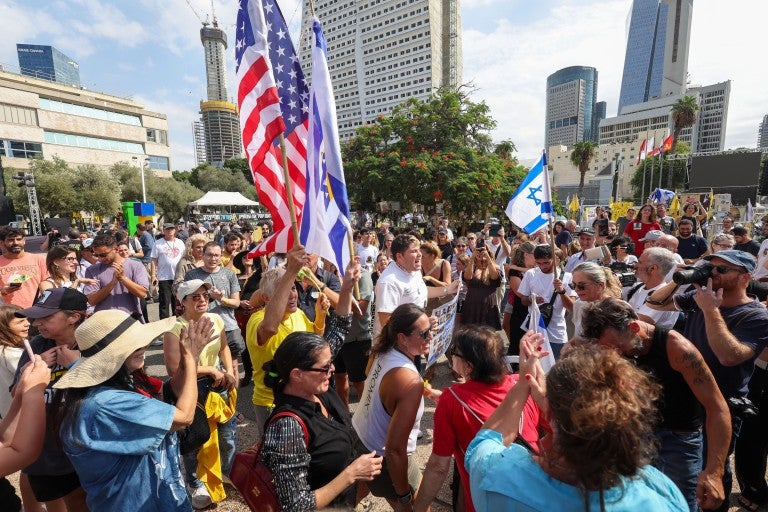April 9, 2018 — Jerusalem, Israel
By Eran Lerman
What led to the relatively high level of Palestinian casualties in the two rounds, so far, of the so-called "March of Return"? To some, the preordained answer is "Israeli brutality" and the IDF's easy finger on the trigger: even some voices within Israel have described these events in terms of soldiers shooting at unarmed "protesters." The ICC Prosecutor General, Fatou Bensouda, saw fit to issue a warning to both sides, including a rare reference to the Palestinian practice of hiding behind civilians, as well as to the use of live fire by the IDF. Some thoughtless statements by Israeli politicians ("there are no innocents in Gaza") added to the vehemence of the debate. But the accusation of premeditated assault on civilians stands at odds with the systematic efforts that the IDF, under Lt. General Gadi Eisenkot's command, has taken in recent years to manage the conflict wisely and reduce the level of friction with the Palestinians wherever possible. Nor does it conform with Israel's active role, which even Qatar acknowledged, in the recent White House initiative to improve living conditions in Gaza. The tag of murderous, racist killers simply does not fit, and in the internal Israeli debate, abrasive as it often is, these allegations have enraged even strong critics of the government's current policies.
The explanation lies elsewhere, and at the most immediate level requires an understanding of the specific topography of the Gaza border. The IDF is obliged to deny access to the actual fence, given the proximity of several kibbutzim – and even of the town of Sderot – to the border. Against the background of the sad record of violence that had already brought three rounds of intensive fighting since Hamas took over in a military coup in June 2007, it was decided to designate a minimal perimeter of a few hundred meters just within the Gaza Strip as a no-go zone, unless a presence in this area is coordinated through the relevant channels, such as the Egyptians. To allow this policy to lapse risks a permanent presence of a mix of civilians and terrorists right up to the border, and perhaps the re-cultivation of the perimeter in a way that would offer cover and shelter to would-be shooters and penetrating squads, whether sent by Hamas, Palestinian Islamic Jihad (an Iranian proxy), or the various Salafi-jihadist groups and ISIS clones that have emerged in Gaza in the wake of broader regional developments.
Thus, the warnings against crossing the perimeter do not come because Israel seeks to "suppress protest," but because the lives of residents in the entire Gaza border area would be exposed to extreme, daily danger if this barrier is not maintained. Ample warning has been given again and again, in all languages. When confronted with the mass of marchers deliberately and knowingly sent into a designated military zone, the IDF chose tactics aimed at dealing with identified activists seeking to reach the border fence and cross it. Those killed – without ruling out the possibility of misidentification -- were mostly, if not all, activists of Hamas and other terror organizations. The large number of those listed as wounded apparently includes many who were hit by non-lethal means. And yet Hamas kept sending more people forward, Friday after Friday.
The rationale, expressed in blunt language by Gaza Prime Minister Yahia Sinwar (a convicted murderer, released by Israel in the Gilad Shalit deal after 22 years in prison), is that Hamas now seeks to obliterate the border through such tactics. This would clearly amount to the obliteration also of the Israeli population in the Gaza border zone, and ultimately, given that Sinwar’s vision is to enter the al-Aqsa Mosque as a conqueror, in all of Israel: Hamas, after all – despite some recent window-dressing – has never acknowledged Israel's right to exist on any inch of what it considers Palestinian soil. By pushing the marchers, including women and young children, ever forward, Hamas (while presented as the initiative of a broad-based multi-party group, it is quite clearly led by the Hamas security services) seeks to win the bitter internal battle for dominance within Palestinian society.
The failure to achieve Palestinian reconciliation—due above all to Hamas's insistence on keeping their guns—has put the movement's leaders in a delicate position. Hope had been building in Gaza for the prospect of a better life under PA management (more corrupt, perhaps, but less brutal than Hamas). By November 2017, as MEMRI has recorded, Al-Jazeerah was reporting a consumer boom in the Strip, with some 10 new shopping malls, dozens of new restaurants, and some hotels. But much of this rested on the expectation that the inner Palestinian rift would be healed and PA authority (and funds) would be at least partly restored. The process collapsed, however, soon after the attempt to assassinate PM Rami Hamdallah and Security Chief Majid Faraj. Hamas, with little in hand, faced a crisis.
Internally, conditions worsened even further when the PA, under Mahmud Abbas's vengeful instructions, cut off funding for electricity and salaries. Militarily, meanwhile, Israeli actions further eroded Hamas's already depleted deck of cards. The fighting in 2014 had already proven that rocket and missile attacks, almost always frustrated by Iron Dome and other Israeli preventive measures, drew a meager harvest at a terrible price. More recently, the threat of the Gaza tunnels lost some of its edge as new technological breakthroughs enabled the detection and destruction of several such projects. Regionally, both Hamas and the PA see unmistakable signs that the key Arab players are increasingly focused on other priorities: the messages coming out of Saudi Arabia and Egypt tell them that they would do well to settle down within the framework the U.S. may soon propose, and negotiate a workable compromise with Israel—on what the Palestinian side angrily describes as Israeli terms.
The timing of the current Gaza border protests is significant – the six-week sequence beginning with Land Day, March 30, and ending with May 14, the date on which the Trump Administration plans to commemorate President Truman's act of recognition, 70 years ago, by moving the U.S. Embassy to Jerusalem. This seemed to give Hamas (masquerading as a non-governmental initiative) an opportunity to extricate itself from its bind by adopting to new tactics: evoking the memory of 1948 while at the same time taking the initiative away from Abbas in the struggle to undo Trump's decision (or at least exact a price for it). Given that the standard Hamas response – suicide bombers, rocket or tunnel attacks – have all led to nothing, the novel option of breaching the border through "human wave" assaults seemed attractive. In the process, Hamas could once again raise the accusation that the IDF was willing to "massacre" civilians. Unfortunately, but not surprisingly, the charge has found willing ears in the Western media and on the political left – including among many misguided people of genuine goodwill who do not even realize that by responding the way they do they only put more lives at risk, since rewarding such Hamas tactics serves to perpetuate them.
The IDF knew all along that this could happen, but with the border being where it is, there was little choice. Failure to prevent a breach, whether now or as the provocations intensify towards May 14, would have catastrophic consequences. Israelis did not need the mix of Palestinian flags and a swastika (which appeared at one point among the marchers) to be reminded of the past. To be sure, the need to restore deterrence must always be weighed against the cost in terms of Israel's moral legitimacy, but this balance cannot be kept at the cost of a kibbutz on the border being overrun, or the sovereignty of Israel being put in question.
Meanwhile, the need to deter becomes even more acute as another milestone looms in mid-May. On the assumption that not enough can be done by May 12 to "fix" the JCPOA, the Trump Administration is likely to "nix" it, setting off a crisis that Iran will surely seek to escalate. Using Palestinian Islamic Jihad as their proxy, the Iranians are likely to try to bring the Gaza situation to the brink of an explosion: one more reason for the IDF and the Israeli authorities to prove as early as possible that the Hamas provocations will not lead to the grandiose promised results – a triumphant entry into Jerusalem – but rather to failure (not to mention ecological degradation due to the large number of tires burnt).
The government of Israel is not beyond reproach. Just last week, the Prime Minister's dramatic turn-about on policy towards African migrants left a lot of Israelis stunned and angry. Nor is the IDF above criticism: it has already assigned a senior officer to look into the events at the border and assess whether mistakes were made, and whether better tactics could have been used. But at the end of the day, full responsibility for the Palestinian blood that has been shed since March 30 must fall upon those who send masses of civilians into a well-defined battle zone, in the name of a plainly articulated plan for the obliteration of Israel.
Eran Lerman is the former deputy for foreign policy and international affairs at the National Security Council in the Israeli Prime Minister's Office. Prior to that, he served as director of AJC Jerusalem.


